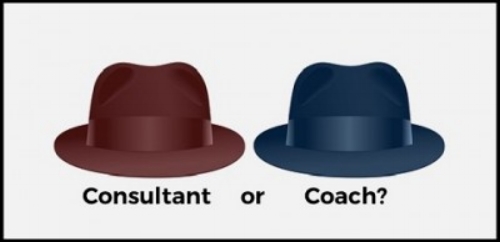Consulting and Coaching: Be Wary of Mixing the Two
/If you describe yourself as both a consultant and coach, this article is for you. There’s a lot of grey area and overlap between the two. Many self-employed professionals go to market as both. For example:
Mary Smith: Executive Coach & Consultant
John Doe: Organization Effectiveness Consultant and Leadership Coach
Usually there’s nothing wrong with this. Nearly all consultants I know consider themselves coaches to some extent because they often have to get a client to do something, to say something a certain way, or to see something they may not want to acknowledge. Sometimes the consultant has to “hold up a mirror” to a senior leader and point out a disruptive behavior that’s hampering the project’s success.
But consultants are not executive coaches. There is a fundamental difference in how each approaches their work. Being conscious of which approach is required is critical to a successful engagement.
Coaching is about helping someone to be more effective or to improve in some way, usually through introspection or reaching their own conclusions. Coaches ask questions that make the client think and figure out things on their own. The premise: get the client to better understand themselves, their situation, and what is in their hands to change, and then to take the appropriate actions.
Consulting is about solving a problem and/or making something happen. Sometimes we call this “get shit done.” Usually clients don’t have the skills or bandwidth to address the situation; that’s why they’ve hired a consultant. They’re counting on you to move the ball down the field, whether through a detailed work plan that’s reviewed regularly, or by cranking out “deliverables”—tools and documents—that will help the client make progress toward the desired result.
Both consulting and coaching engagements often start the same way, with some kind of assessment to get a baseline understanding. After that, though, the methodologies diverge. In addition to the approach, a big difference between the two is where the ownership lies. With coaching the client is the driver of progress; in consulting, the consultant is the driver.
So what’s the problem with being both a consultant and coach?
Sometimes it’s not clear what the client wants or needs, and the consultant isn’t clear on which hat they are wearing: coach or consultant. If there’s a mismatch, dissatisfaction is soon to follow.
I learned this the hard way recently when a consultant I represented was acting more like a coach, and the client needed someone to get shit done. Let’s call him Bob. The project started out well, with Bob taking the initiative to do an assessment to understand stakeholder perceptions. (An initial assessment is common with both coaching and consulting.) He discovered that the senior leaders were not aligned on the vision for the initiative so the project took a step sideways to get the needed alignment. A month later when it was time for Bob to really engage again, something had shifted and, according to the client, he was no longer taking the initiative and driving the work.
After I spoke with the client, then with the consultant, and then with the client again, I realized that Bob had slipped into a coaching role. He was trying to lead the client to come up with their own solution; he was being too collaborative. For example, he was saying things like, “What else do you think we should do to make it complete?” instead of saying things like, “Based on what I’ve heard, I recommend you go with X, Y, and Z and leave out Q,” which is a more direct approach. The client wanted a detailed plan with deliverables and due dates that the consultant would use to hold them accountable; instead Bob gave them a strategy (guiding principles) and an overall approach for implementation. The client also wanted show-ready deliverables, but Bob was giving them drafts for discussion—too collaborative and too time consuming for the client.
Bob had slipped into his coaching persona and was not moving the ball down the field. By the time the client brought this to my attention, too much had gone wrong—the client didn’t trust the consultant and the consultant had lost his confidence to deliver what the client wanted. They agreed to part ways before the project was done, but the client was dismayed to have spent nearly $50,000 with little to show for it. I refunded 100% of my agency’s fees, but the client still felt like she didn’t get her money’s worth.
Obviously, this is bad for my agency but it’s especially bad for Bob if he wants a career in consulting. As a self-employed consultant, your reputation is paramount since most work comes via referrals. I will no longer refer Bob to clients for consulting projects. It’s a good thing he wants to build his coaching practice. As a result of this experience, he is now more aware of his default style and focusing on his preferred type of work. (This relates to my earlier blog post, “Know Your Niche.”)
The lesson: Be very clear about what the client wants and needs, and be ever-conscious of which persona you’re bringing to the engagement. Coaches usually don’t tell their clients what to do or when to do it, but consultants often do. Is the client hiring you to help them find their own way, or to “get shit done?” If you’re uncertain, talk with your client. Aligning expectations is critical to success.



